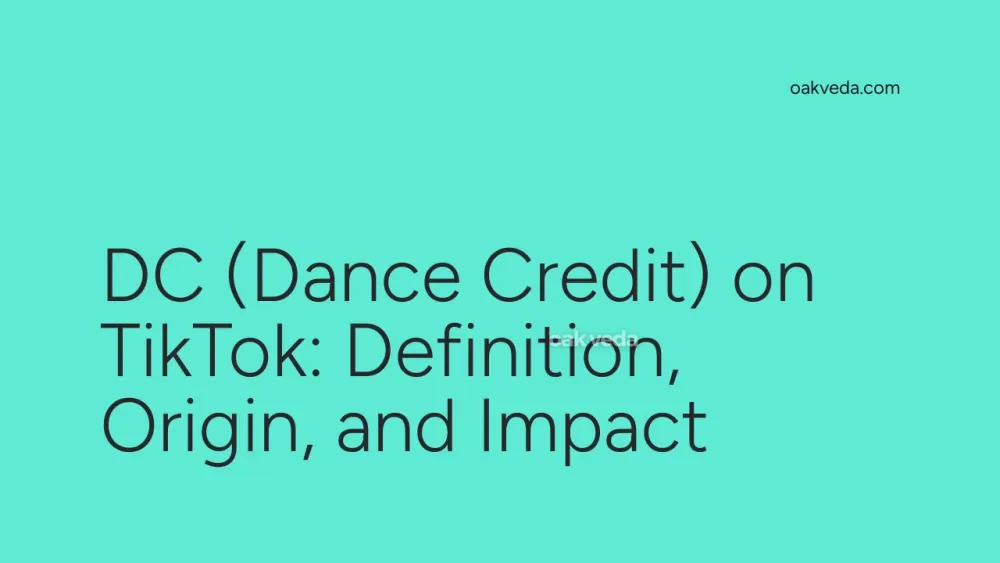
What is DC (Dance Credit) on TikTok?
DC, short for "Dance Credit," is a crucial concept on TikTok that refers to the practice of acknowledging and giving credit to the original creator of a dance routine or choreography. This term has become increasingly important as dance challenges and trends have become a cornerstone of TikTok's content ecosystem.
Origin and Development of DC
The concept of dance credit emerged as TikTok's popularity exploded, particularly around 2019-2020. As dance challenges went viral, concerns arose about proper attribution for original choreographers, many of whom were young creators of color. The platform faced criticism for allowing popular dances to spread without crediting their originators, leading to a cultural shift towards more conscious crediting practices.
How DC Works on TikTok
When users create videos featuring popular dance routines, they're encouraged to include a "DC" or "Dance Credit" in their captions or comments. This typically involves:
- Mentioning the original creator's username
- Using hashtags like #dc or #dancecredit
- Tagging the creator in the video
- Utilizing TikTok's built-in crediting features
TikTok has since introduced features to facilitate easier crediting, such as the ability to tag other users directly in video captions and add links to the original creator's content.
Popular Examples of DC in Action
Several high-profile cases have highlighted the importance of dance credit:
- The "Renegade" dance, created by Jalaiah Harmon, went viral without initial credit, leading to discussions about proper attribution.
- Charli D'Amelio, one of TikTok's biggest stars, began consistently crediting dance creators, setting a positive example for her millions of followers.
- The "Savage" dance by Keara Wilson gained widespread recognition after Megan Thee Stallion herself acknowledged the creator.
Impact of DC on Social Media Culture
The emphasis on dance credit has had several significant impacts:
- Increased awareness of intellectual property: Users are more conscious of the creative work behind viral content.
- Empowerment of creators: Original choreographers gain recognition and potential career opportunities.
- Community building: Proper crediting fosters a more collaborative and supportive TikTok community.
- Cultural conversations: DC has sparked discussions about appropriation and attribution in digital spaces.
Controversies and Debates Surrounding DC
While DC has become more prevalent, it's not without controversy:
- Inconsistent application: Some users still fail to provide proper credit, either intentionally or out of ignorance.
- Platform responsibility: Debates continue about TikTok's role in enforcing or encouraging proper crediting.
- Monetization issues: Questions arise about how original creators can benefit financially from their viral dances.
How Brands and Influencers Use DC
Savvy brands and influencers have recognized the importance of DC in their TikTok strategies:
- Collaboration opportunities: Brands often partner with original dance creators for campaigns.
- Authenticity and ethics: Proper crediting enhances an influencer's reputation and ethical standing.
- Engagement boost: Videos that credit original creators often see increased engagement through community support.
Future Trends Related to DC
As TikTok and other platforms evolve, we can expect to see:
- Automated crediting systems: AI-powered tools may help identify and credit original creators automatically.
- Expanded creator tools: Platforms may introduce more robust features for tracking and managing dance credits.
- Legal frameworks: Potential development of copyright systems specific to short-form dance content.
- Cross-platform crediting: As dances spread across different social media, universal crediting standards may emerge.
FAQs about DC (Dance Credit)
Q: Is it mandatory to give dance credit on TikTok? A: While not strictly mandatory, it's highly encouraged and considered good etiquette within the TikTok community.
Q: How can I find the original creator of a dance? A: Look for the earliest videos using the dance, check popular dance challenge hashtags, or use TikTok's "Original sound" feature to trace the choreography's origin.
Q: Can I get in trouble for not giving dance credit? A: While there's no official punishment, failing to credit can lead to community backlash and potential damage to your reputation on the platform.
Q: How has DC affected the careers of dance creators? A: Proper crediting has led to numerous opportunities for original creators, including brand deals, media appearances, and even professional dance careers.
In conclusion, DC (Dance Credit) has become an integral part of TikTok's culture, promoting fairness, creativity, and community. As the platform continues to evolve, the practice of giving credit to original dance creators will likely become even more sophisticated and ingrained in social media etiquette. By understanding and implementing proper dance crediting, users can contribute to a more equitable and collaborative digital environment.
You may be interested in:
- Komi: Definition, Origin, and Impact on Creator Marketing
- SMB: Definition, Origin, and Impact on Social Media Marketing
- "I'm Baby": Definition, Origin, and Impact
- Tube Girl: Definition, Origin, and Impact on Social Media
- Target Audience: Definition, Origin, and Impact on Social Media
- Aesthetic: Definition, Origin, and Impact on Social Media

